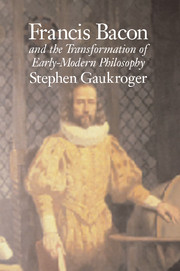Book contents
- Frontmatter
- Contents
- Acknowledgments
- References to Bacon's works
- Prologue
- 1 The nature of Bacon's project
- 2 Humanist models for scientia
- 3 The legitimation of natural philosophy
- 4 The shaping of the natural philosopher
- 5 Method as a way of pursuing natural philosophy
- 6 Dominion over nature
- Conclusion
- Bibliography
- Index
4 - The shaping of the natural philosopher
Published online by Cambridge University Press: 12 January 2010
- Frontmatter
- Contents
- Acknowledgments
- References to Bacon's works
- Prologue
- 1 The nature of Bacon's project
- 2 Humanist models for scientia
- 3 The legitimation of natural philosophy
- 4 The shaping of the natural philosopher
- 5 Method as a way of pursuing natural philosophy
- 6 Dominion over nature
- Conclusion
- Bibliography
- Index
Summary
The psychology of knowledge
In 1597, at the age of thirty-seven, Bacon published his first book, a slim octavo collection containing three works: a collection of ten brief English Essayes, the short Latin essay Meditationes Sacrae, and Coulers of Good and Evill a Fragment. The term ‘essay’ literally means ‘attempt’ (Fr. essai), and essays were generally aphoristic and thought-provoking: They were not designed to survey a field in any detail. It was Montaigne who had made the essay form such a success in the early-modern era, but although there can be little doubt that Bacon would have read Montaigne by 1597, he does not mention him as a source. Also, there are significant differences between Montaigne's essays and those of Bacon. Whereas Montaigne is enticing, drawing the reader in, shifting from the personal to the general, from the serious to the capricious, Bacon's tone is didactic throughout. Montaigne aims at a broad audience, while Bacon seems to be writing for the court: The Essayes are much closer to Castiligione than Montaigne, both in genre and in tone.
The Essayes proper – which deal briefly with study, with speech (‘discourse’), ceremonies, followers and friends, lawsuits, spending money, health, honour and reputation, political factions, and negotiation – are resolutely practical. The first, ‘Of Studies’, does, however, draw attention to two enduring themes in Bacon, namely, the superiority of the learned in making judgements, and the notion that the value of studies is to be tied to their usefulness. Moreover, the instruction that we must ‘reade not to contradict, nor to belieue, but to waigh and consider’ is surely an implicit rebuke to Scholastic methods of teaching.
- Type
- Chapter
- Information
- Francis Bacon and the Transformation of Early-Modern Philosophy , pp. 101 - 131Publisher: Cambridge University PressPrint publication year: 2001



